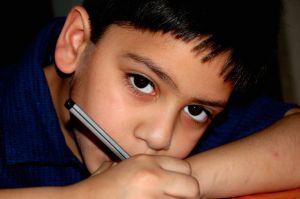As a teacher, especially in the last few years, my classes are increasingly full of kids with the increasingly common Attention Deficit Hyperactivity Disorder (ADHD) diagnosis. These kids are almost all endearing, engaged, and downright bouncy. ADHD children often respond well to medication, get along well with their peers, and seem to be happy and adjusted. They are five times more likely to be boys than girls, often smaller than average, often allergy sufferers. No teacher seems to be surprised with a diagnosis of ADHD, and many parents are at peace with it as well.
After all, it can be controlled, right? ADHD is the most common, and one of the most well understood, disorders affecting children today. About 5 in 100 children will be diagnosed with ADHD, and about 80 percent are boys. Most children are diagnosed before the age of seven, and only about 30 percent of these children will continue to show symptoms into adulthood. See the Centers for Disease Control and Prevention (CDC) website for more information on the number of children affected: http://www.cdc.gov/ncbddd/adhd/data.html
The prognosis is good. The brain forges new pathways, the children learn to cope with the symptoms, the medication is weaned in adolescence, and the child becomes a successful adult. Often, with academic interventions and support, children with ADHD thrive in school and in life. Many successful, famous people admit to suffering with ADHD as children, among them Ty Pennington, Glenn Beck, Jamie Oliver, Jim Carrey, Will Smith, and Michael Phelps.
But who are the kids without the “H”? Originally, these children were labeled as Attention Deficit Disorder, or ADD. The Diagnostic and Statistical Manual of Mental Disorders, fourth edition (DSM-IV) officially got rid of ADD as a diagnosis in 1994, changing this subset of ADHD into Attention Deficit Hyperactivity Disorder-predominantly inattentive, or ADHD-PI. While these children are also often boys, they don’t have many of the rather obvious symptoms “traditional” ADHD sufferers show. Because of this, the disorder is frequently missed or misdiagnosed, leading to lifelong emotional and academic struggles for these children.
The face of ADHD-PI, to me, is quite a beautiful one: topped by thick, rather unruly dark brown hair, with big dark eyes fringed with lashes too long for any boy to have, an almost-perfect straight nose, a prominent and slightly cleft chin, high cheekbones, and a big grin with slightly crooked growing-in teeth. My nine year old son suffers from this little-understood cousin to ADHD, but we are among the lucky ones, with a diagnosis and treatment plan in place.
How does ADHD-PI differ from other attention disorders?
The symptoms of ADHD-PI are different than pure ADHD, and often easy to miss. They include disorganization, procrastination, anxiety, and a fear of group assignments or overly structured situations. Students with ADHD-PI can be labeled as “lazy” in regards to the work and “immature” in regards to the anxieties, leading them to poor academic performance. These children often have a higher-than-average intelligence, as do other ADHD sufferers, but lower-than-average performance when left untreated.
In fact, Dr. Russell Barkley, in the journal Clinical Psychology, argues that ADHD-PI is so distinct from mainstream ADHD that it should be considered a completely separate disorder. This article can be accessed here: http://onlinelibrary.wiley.com/doi/10.1093/clipsy.8.4.489/abstract. He cites the almost complete lack of conduct disorders and high-risk behaviors in children with ADHD-PI, and an increase in anxiety conditions, as some of his main reasons for this.
What was once seen as a type of ADHD-PI is gaining new prominence in the medical community. This is a condition known as Sluggish Cognitive Tempo (SCT), which is characterized by daydreaming, mental fogginess, and an inability to separate important information from irrelevant. First brought up as separate from ADHD-PI in 2007, SCT is slowly gaining notoriety. According to Dr. Robert Eme, ADHD-PI and SCT should be classified as separate disorders, though some of the symptoms are the same. While ADHD-PI is characterized by an external inattentiveness (for example, the child is distracted by another, more interesting thing), the inattentiveness of SCT seems to be internal. Like ADHD sufferers, children diagnosed as SCT have above-average intelligence. However, performance tends to be lower in these children, even with diagnosis and treatment. Since SCT is a relatively new diagnosis, the long term prognosis remains unknown. To read Dr. Eme’s article, please visit: http://adhdrollercoaster.org/adult-adhd-diagnosis-issues/a-new-type-of-adhd-for-next-dsm-revision/#.T3nnLtn4KbI
How rare is ADHD-PI, really? How many children are affected?
While no complete, long-reaching estimates of numbers of children affected exist for ADHD-PI, due to the relatively new information available, many estimate that about 3-5 percent of American children have some form of ADHD. ADHD-PI is relatively rare, with perhaps 5-10 percent of those diagnosed as ADHD fitting into this subgroup. That would lead to .0025 percent of American children; however, the condition is under-diagnosed, so the actual number is most likely much higher. More about the prevalence of ADHD and related disorders can be found from The National Institute of Mental Health here: http://www.nimh.nih.gov/statistics/1ADHD_CHILD.shtml
Are there other disorders that are co-morbid with ADHD-PI?
Yes. The main disorder that ADHD-PI children suffer with is obsessive compulsive disorder, or OCD. OCD is primarily an anxiety disorder, with unreasonable thoughts and fears. The main symptoms of OCD are broken into obsessions and compulsions. An example of a common obsession OCD sufferers exhibit is a fascination with cleanliness, orderliness, or perfection. An example of a compulsion is frequent hand washing or checking and rechecking something (such as whether a door is locked or a stove is turned off). Other common co-morbid disorders include depression and other anxiety disorders. More rarely, ADHD-PI is co-morbid with bipolar or autism spectrum disorders. ADHD-PI is almost never co-morbid with conduct disorders such as Oppositional Defiance Disorder, which is seen in nearly 30 percent of ADHD sufferers.
More information about OCD and other anxiety disorders can be found from the Mayo Clinic here: http://www.mayoclinic.com/health/obsessive-compulsive-disorder/DS00189
How is ADHD-PI treated? How is this different from ADHD?
The good news is, most of the drugs used to treat “traditional” ADHD are also affective in ADHD-PI. The most common medications prescribed are the methylphenidate family, which has brand names such as Concerta and Ritalin, Strattera, Vyvanze, and Adderall. In addition, when necessary, anti-depressants like Prozac and Zoloft can be prescribed to treat anxiety issues.
Medication will help but not cure the symptoms of ADHD-PI. In addition to medication, behavioral therapy and educational accommodations are often needed to help the individual cope with his or her symptoms. Most ADHD-PI sufferers will learn, through therapy, to live with their symptoms; few adults still need to be treated with medication for this condition.
What are the dangers of un or misdiagnosed ADHD-PI?
Undiagnosed or untreated ADHD-PI can lead to poor academic growth. Many untreated ADHD-PI sufferers tend to drop out of school at a younger age, or find alternative paths to education such as non-traditional classroom settings. Many ADHD-PI sufferers do not reach their full academic potential, according to Santo Triolo, author of Attention Deficit Disorder in the Hood: A Practitioner’s Handbook. They, as adults, tend to suffer from poor self image and ongoing problems with maintaining healthy relationships, issues with job performance, mood disorders, and even substance abuse.
Recently, Justin Timberlake came forward about his struggle with OCD and ADHD-PI. He has been quoted as saying “I have OCD mixed with ADD. You try living with that. It’s complicated”. Perhaps this sums up the whole disorder in a simple, yet completely relevant way. ADHD-PI is complicated. The diagnosis, the treatment, and ultimately the success of ADHD-PI is very complicated. Justin has managed to overcome his disorders and lead a very successful life. I have no doubt my son will do the same.
To read more about Justin Timberlake’s struggle with ADHD-PI, read the article at http://add.about.com/b/2008/06/27/justin-timberlake-reveals-he-has-both-add-and-ocd.htm
What can we, as parents, do?
Ultimately, a child’s first and best advocates should be his or her parents. When your child is diagnosed with ADHD-PI, or if you suspect your child may suffer from this condition, the first place to go it to your pediatrician. Though the disorder is under-diagnosed and not completely understood, it is gaining prevalence among both the medical and educational community. The best way to begin fighting a disorder is to understand it, and the outcome for most children who suffer from ADHD-PI is quite good with treatment. So, ask questions, get a second opinion, and most of all, realize you are your child’s best resource.








